Event-Driven Shoreline Dynamics of the Nile, Indus, and Yellow River Deltas: A 50-Year Analysis of Trends and Responses
Abstract
1. Introduction
1.1. Study Area
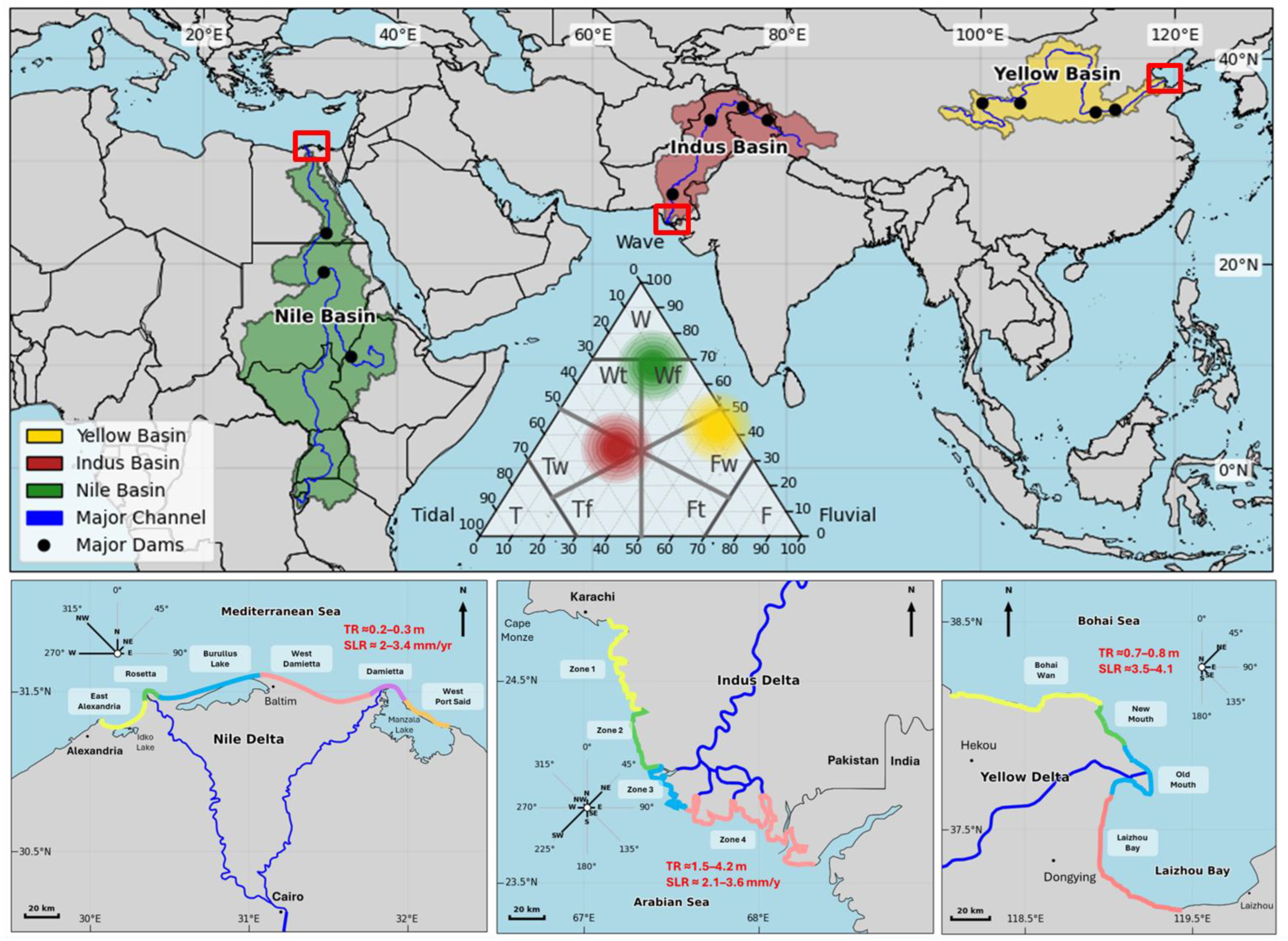
1.2. Background
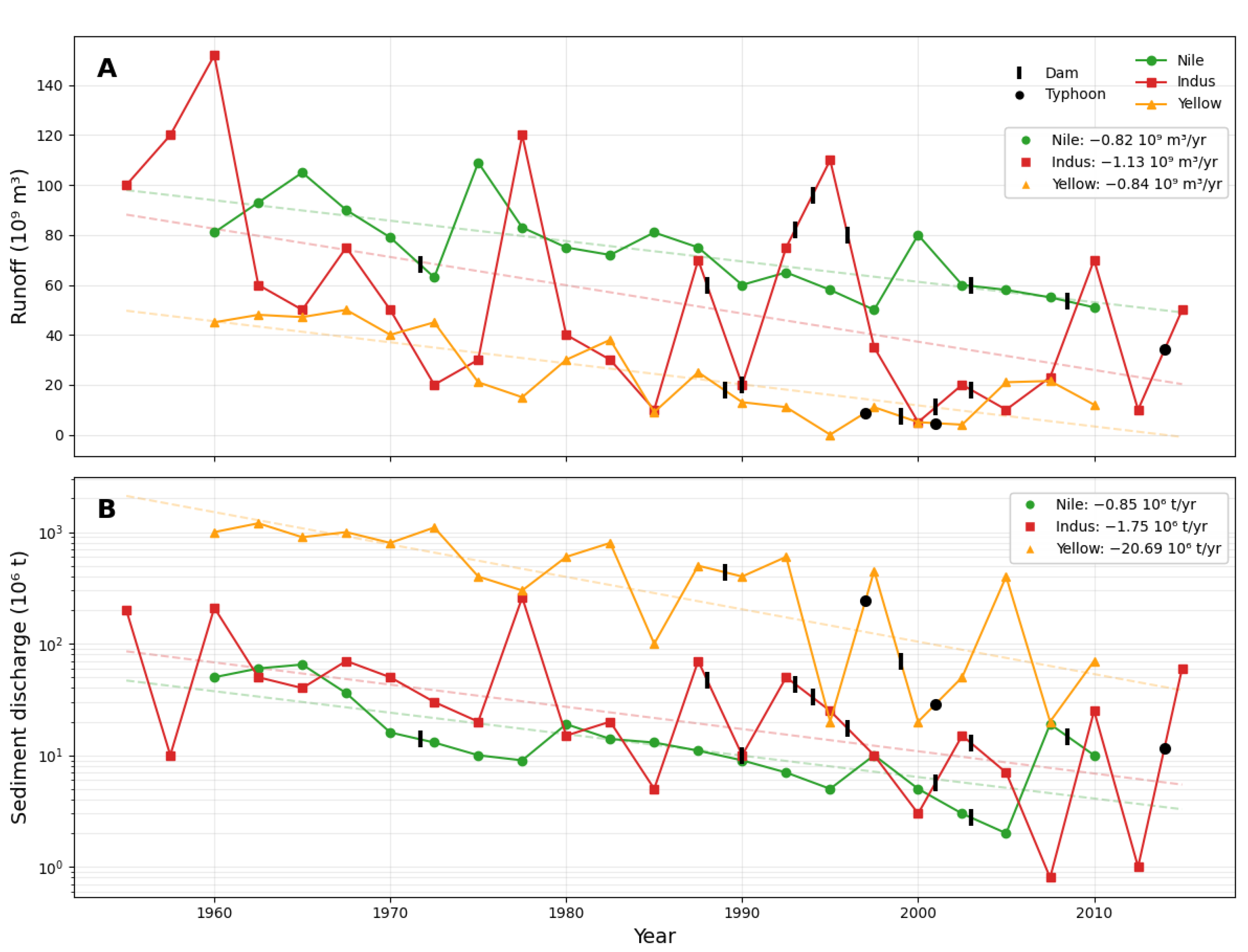
2. Materials and Methods
2.1. Dataset
2.2. Data Preprocessing
2.3. Historical Shoreline Data Analysis
3. Results
4. Discussion
5. Conclusions
Supplementary Materials
Author Contributions
Funding
Data Availability Statement
Acknowledgments
Conflicts of Interest
References
- Zhang, W.; Xu, Y.J.; Guo, L.; Lam, N.S.-N.; Xu, K.; Yang, S.; Yao, Q.; Liu, K.-B. Comparing the Yangtze and Mississippi River Deltas in the light of coupled natural-human dynamics: Lessons learned and implications for management. Geomorphology 2022, 399, 108075. [Google Scholar] [CrossRef]
- Angamuthu, B.; Darby, S.E.; Nicholls, R.J. Impacts of natural and human drivers on the multi-decadal morphological evolution of tidally-influenced deltas. Proc. R. Soc. A Math. Phys. Eng. Sci. 2018, 474, 20180396. [Google Scholar] [CrossRef] [PubMed]
- Ciavola, P.; Mantovani, F.; Simeoni, U.; Tessari, U. Relation between river dynamics and coastal changes in albania: An assessment integrating satellite imagery with historical data. Int. J. Remote Sens. 1999, 20, 561–584. [Google Scholar] [CrossRef]
- Woodroffe, C.D.; Murray-Wallace, C.V. Sea-level rise and coastal change: The past as a guide to the future. Quat. Sci. Rev. 2012, 54, 4–11. [Google Scholar] [CrossRef]
- Williams, B.A.; Watson, J.E.; Beyer, H.L.; Klein, C.J.; Montgomery, J.; Runting, R.K.; Roberson, L.A.; Halpern, B.S.; Grantham, H.S.; Kuempel, C.D.; et al. Global rarity of intact coastal regions. Conserv. Biol. 2022, 36, e13874. [Google Scholar] [CrossRef]
- Edmonds, D.A.; Caldwell, R.L.; Brondizio, E.S.; Siani, S.M. Coastal flooding will disproportionately impact people on river deltas. Nat. Commun. 2020, 11, 4741. [Google Scholar] [CrossRef]
- Oestigaard, T. Water Scarcity and Food Security Along the Nile: Politics, Population Increase and Climate Change; Nordiska Afrikainstitutet: Uppsala, Sweden, 2012; Volume 1. Available online: https://www.files.ethz.ch/isn/152248/FULLTEXT01-5.pdf (accessed on 18 August 2022).
- Kalhoro, N.A.; He, Z.; Li, L.; Xu, D.; Jun, W.; Zeb, A.; Khaskheli, N. Spatial and temporal variations of hydrodynamics and sediment dynamics in Indus River Estuary, Pakistan. Glob. Nest J. 2021, 23, 572–580. [Google Scholar]
- Miao, C.; Ni, J.; Borthwick, A.G. Recent changes of water discharge and sediment load in the Yellow River basin, China. Prog. Phys. Geogr. 2010, 34, 541–561. [Google Scholar] [CrossRef]
- Shi, L.; Wang, Y. Evolution characteristics and driving factors of negative decoupled rural residential land and resident population in the Yellow River Basin. Land Use Policy 2021, 109, 105685. [Google Scholar] [CrossRef]
- Solangi, G.S.; Siyal, A.A.; Siyal, P. Indication of subsurface seawater intrusion into the Indus delta, Sindh, Pakistan. Mehran Univ. Res. J. Eng. Technol. 2023, 42, 9–16. [Google Scholar] [CrossRef]
- Shi, Y.; Zhu, J.; Xie, Z.; Ji, Z.; Jiang, Z.; Yang, G. Prediction and prevention of the impacts of sea level rise on the Yangtze River Delta and its adjacent areas. Sci. China Ser. D Earth Sci. 2000, 43, 412–422. [Google Scholar]
- El Sayed Frihy, O.; Deabes, E.A.; Shereet, S.M.; Abdalla, F.A. Alexandria-Nile Delta coast, Egypt: Update and future projection of relative sea-level rise. Environ. Earth Sci. 2010, 61, 253–273. [Google Scholar] [CrossRef]
- El-Asmar, H.M.; Hereher, M.E. Change detection of the coastal zone east of the Nile Delta using remote sensing. Environ. Earth Sci. 2011, 62, 769–777. [Google Scholar] [CrossRef]
- Risha, M. Coastal Evolution of the Nile, Indus, and Yellow River Deltas: Historical Analysis, and Machine Learning Prediction for Future Shoreline. Master’s Thesis, NC State University, Raleigh, NC, USA, 20 August 2024. [Google Scholar]
- Risha, M.; Liu, P. Shoreline Prediction Models: A Review of the Evolution from Empirical to AI Machine Learning Approaches. Preprint 2025. [Google Scholar] [CrossRef]
- Syvitski, J.P.M.; Kettner, A.J.; Overeem, I.; Hutton, E.W.H.; Hannon, M.T.; Brakenridge, G.R.; Day, J.; Vörösmarty, C.; Saito, Y.; Giosan, L.; et al. Sinking deltas due to human activities. Nat. Geosci. 2009, 2, 681–686. [Google Scholar] [CrossRef]
- Inam, A.; Clift, P.D.; Giosan, L.; Alizai, A.; Kidwai, S.; Shahzad, M.I.; Zia, I.; Nazeer, M.; Khan, M.J.; Ali, S.S. The Geographic, Geological, and Oceanographic Setting of the Indus River—An Update. In Large Rivers: Geomorphology and Management, 2nd ed.; John Wiley and Sons: Hoboken, NJ, USA, 2022; pp. 488–520. [Google Scholar]
- Kuenzer, C.; Heimhuber, V.; Huth, J.; Dech, S. Remote sensing for the quantification of land surface dynamics in large river delta regions—A review. Remote Sens. 2019, 11, 1985. [Google Scholar] [CrossRef]
- Khan, S.I.; Adams, T.E. Indus River Basin: Water Security and Sustainability; Elsevier: Amsterdam, The Netherlands, 2019. [Google Scholar]
- Zhu, Z.; Giordano, M.; Cai, X.; Molden, D. Yellow River Comprehensive Assessment Basin Features and Issues; Working Paper 57; IWMI: Colombo, Sri Lanka, 2003. [Google Scholar]
- Giordano, M.; Zhu, Z.; Cai, X.; Hong, S. Water Management in the Yellow River Basin: Background, Current Critical Issues and Future Research Needs; IWMI: Colombo, Sri Lanka, 2004; Volume 3. [Google Scholar]
- Noaman, M.N.; El Quosy, D. Hydrology of the nile and ancient agriculture. In Irrigated Agriculture in Egypt Past, Present and Future; Springer International Publishing: Cham, Switzerland, 2017; pp. 9–28. [Google Scholar]
- Galloway, W.E. Process framework for describing the morphologic and stratigraphic evolution of deltaic systems. In Deltas: Models for Exploration; Houston Geological Society: Houston, TX, USA, 1975; pp. 87–98. [Google Scholar]
- Nyberg, B.; Howell, J.A. Global distribution of modern shallow marine shorelines. Implications for exploration and reservoir analogue studies. Mar. Pet. Geol. 2016, 71, 83–104. [Google Scholar] [CrossRef]
- Li, H.; Zhang, Q.; Singh, V.P.; Shi, P.; Sun, P. Hydrological effects of cropland and climatic changes in arid and semi-arid river basins: A case study from the Yellow River basin, China. J. Hydrol. 2017, 549, 547–557. [Google Scholar] [CrossRef]
- Forsythe, N.; Fowler, H.J.; Blenkinsop, S.; Burton, A.; Kilsby, C.G.; Archer, D.R.; Harpham, C.; Hashmi, M.Z. Application of a stochastic weather generator to assess climate change impacts in a semi-arid climate: The Upper Indus Basin. J. Hydrol. 2014, 517, 1019–1034. [Google Scholar] [CrossRef]
- Abd-Elaty, I.; Sallam, G.A.H.; Straface, S.; Scozzari, A. Effects of climate change on the design of subsurface drainage systems in coastal aquifers in arid/semi-arid regions: Case study of the Nile delta. Sci. Total Environ. 2019, 672, 283–295. [Google Scholar] [CrossRef] [PubMed]
- Zhao, F.; Ma, S.; Wu, Y.; Qiu, L.; Wang, W.; Lian, Y.; Chen, J.; Sivakumar, B. The role of climate change and vegetation greening on evapotranspiration variation in the Yellow River Basin, China. Agric. For. Meteorol. 2022, 316, 108842. [Google Scholar] [CrossRef]
- Liaqat, U.W.; Choi, M.; Awan, U.K. Spatio-temporal distribution of actual evapotranspiration in the Indus Basin Irrigation System. Hydrol. Process. 2015, 29, 2613–2627. [Google Scholar] [CrossRef]
- Bastiaanssen, W.G.M.; Cheema, M.J.M.; Immerzeel, W.W.; Miltenburg, I.J.; Pelgrum, H. Surface energy balance and actual evapotranspiration of the transboundary Indus Basin estimated from satellite measurements and the ETLook model. Water Resour. Res. 2012, 48. [Google Scholar] [CrossRef]
- Gebrehiwot, S.G.; Ellison, D.; Bewket, W.; Seleshi, Y.; Inogwabini, B.; Bishop, K. The Nile Basin waters and the West African rainforest: Rethinking the boundaries. Wiley Interdiscip. Rev. Water 2019, 6, e1317. [Google Scholar] [CrossRef]
- Yates, D.N.; Strzepek, K.M. Modeling the Nile Basin under climatic change. J. Hydrol. Eng. 1998, 3, 98–108. [Google Scholar] [CrossRef]
- Hersbach, H.; Bell, B.; Berrisford, P.; Biavati, G.; Horányi, A.; Sabater, J.M.; Nicolas, J.; Peubey, C.; Radu, R.; Rozum, I. ERA5 hourly data on single levels from 1940 to present. Copernicus Clim. Chang. Serv. Clim. 2023, 10. [Google Scholar] [CrossRef]
- Wu, X.; Bi, N.; Xu, J.; Nittrouer, J.A.; Yang, Z.; Saito, Y.; Wang, H. Stepwise morphological evolution of the active Yellow River (Huanghe) delta lobe (1976–2013): Dominant roles of riverine discharge and sediment grain size. Geomorphology 2017, 292, 115–127. [Google Scholar] [CrossRef]
- Wu, L.; Yuan, J.; Wu, Z.; Hu, L.; Zhang, J.; Sun, J. An Updated Analysis of Long-Term Sea Level Change in China Seas and Their Adjacent Ocean with T/P: Jason-1/2/3 from 1993 to 2022. J. Mar. Sci. Eng. 2024, 12, 1889. [Google Scholar] [CrossRef]
- El-Geziry, T.M.; El-Wakeel, Y.M. A decadal sea-level variability in Port-Said Harbour (Egypt). Egypt. J. Aquat. Res. 2023, 49, 33–39. [Google Scholar] [CrossRef]
- Khan, F.A.; Khan, T.M.A.; Ahmed, A.N.; Afan, H.A.; Sherif, M.; Sefelnasr, A.; El-Shafie, A. Complex extreme sea levels prediction analysis: Karachi coast case study. Entropy 2020, 22, 549. [Google Scholar] [CrossRef]
- Tonbol, K.; Shaltout, M. Tidal and non-tidal sea level off Port Said, Nile Delta, Egypt. JKAU Mar. Sci. 2013, 24, 69–83. [Google Scholar] [CrossRef]
- El-Sayed, M.K. Rising sea-level and subsidence of the Northern Nile delta: A case study. In Sea-Level Rise and Coastal Subsidence: Causes, Consequences, and Strategies; Springer: Berlin/Heidelberg, Germany, 1996; pp. 215–233. [Google Scholar]
- Abdrabo, M.A.; Hassaan, M.A. Economic valuation of sea level rise impacts on agricultural sector: Damietta Governorate, Egypt. J. Environ. Prot. 2014, 5, 52012. [Google Scholar] [CrossRef]
- Stanley, D.J. Nile delta: Extreme case of sediment entrapment on a delta plain and consequent coastal land loss. Mar. Geol. 1996, 129, 189–195. [Google Scholar] [CrossRef]
- Frihy, O.E.; Stanley, J.D. The Modern Nile Delta Continental Shelf, with an Evolving Record of Relict Deposits Displaced and Altered by Sediment Dynamics. Geographies 2023, 3, 416–445. [Google Scholar] [CrossRef]
- Ijaz, M.W.; Mahar, R.B.; Siyal, A.A.; Anjum, M.N. Geospatial analysis of creeks evolution in the Indus Delta, Pakistan using multi sensor satellite data. Estuar. Coast. Shelf Sci. 2018, 200, 324–334. [Google Scholar] [CrossRef]
- Zhang, J.; Wan, S.; Clift, P.D.; Huang, J.; Yu, Z.; Zhang, K.; Mei, X.; Liu, J.; Han, Z.; Nan, Q. History of Yellow River and Yangtze River delivering sediment to the Yellow Sea since 3.5 Ma: Tectonic or climate forcing? Quat. Sci. Rev. 2019, 216, 74–88. [Google Scholar] [CrossRef]
- Wu, X.; Xu, J.; Wu, H.; Bi, N.; Bian, C.; Li, P.; Wang, A.; Duan, H.; Wang, H. Synoptic variations of residual currents in the Huanghe (Yellow River)-derived distal mud patch off the Shandong Peninsula: Implications for long-term sediment transport. Mar. Geol. 2019, 417, 106014. [Google Scholar] [CrossRef]
- Zhang, X.-L.; Li, P.-Y. Regional natural disaster risk of coastal wetland in Yellow River Delta. Ziran Zaihai Xuebao/J. Nat. Disasters 2006, 15, 159–164. [Google Scholar]
- Gupta, H.; Kao, S.J.; Dai, M. The role of mega dams in reducing sediment fluxes: A case study of large Asian rivers. J. Hydrol. 2012, 464–465, 447–458. [Google Scholar] [CrossRef]
- Kalhoro, N.A.; He, Z.; Xu, D.; Faiz, M.; Yafei, L.V.; Sohoo, N.; Bhutto, A.H. Vulnerability of the indus river delta of the North Arabian Sea, Pakistan. Glob. Nest J. 2016, 18, 599–610. [Google Scholar]
- Shalash, S. Effects of sedimentation on the storage capacity of the High Aswan Dam reservoir. Hydrobiologia 1982, 91, 623–639. [Google Scholar] [CrossRef]
- Haq, B.U.; Milliman, J.D. Perilous Future for River Deltas. GSA Today 2023, 33, 4–12. [Google Scholar] [CrossRef]
- Khan, M.Z.; Akbar, G. In the Indus Delta it is No More the Mighty Indus. In River Conservation and Management; John Wiley and Sons: Hoboken, NJ, USA, 2012; pp. 69–78. [Google Scholar]
- Wang, J.; Dai, Z.; Fagherazzi, S.; Lou, Y.; Mei, X.; Ma, B. Large-scale sedimentary shift induced by a mega-dam in deltaic flats. Sedimentology 2024, 71, 1084–1112. [Google Scholar] [CrossRef]
- Kravtsova, V.I.; Mikhailov, V.N.; Efremova, N.A. Variations of the hydrological regime, morphological structure, and landscapes of the Indus River delta (Pakistan) under the effect of large-scale water management measures. Water Resour. 2009, 36, 365–379. [Google Scholar] [CrossRef]
- Fu, Y.; Bellerby, R.G.J.; Ji, H.; Chen, S.; Fan, Y.; Li, P. Impacts of Riverine Floods on Morphodynamics in the Yellow River Delta. Water 2023, 15, 1568. [Google Scholar] [CrossRef]
- Bianchi, T.S. Saving the Deltas. In Deltas and Humans; Oxford University Press: Oxford, UK, 2016; p. 112. [Google Scholar]
- Woodward, J.C.; MackLin, M.G.; Krom, M.D.; Williams, M.A.J. The River Nile: Evolution and environment. In Large Rivers Geomorphology Management; John Wiley and Sons: Hoboken, NJ, USA, 2022; pp. 388–432. [Google Scholar]
- Halim, Y.; Morcos, S.A.; Rizkalla, S.; El-Sayed, M.K. The Impact of the Nile and the Suez Canal on the Living Marine Resources of the Egyptian Mediterranean Waters (1958–1986); FAO: Rome, Italy, 1995. [Google Scholar]
- Wilson, M.D.; Pittma, E.D. Authigenic Clays in Sandstones: Recognition and Influence on Reservoir Properties and Paleoenvironmental Analysis. SEPM J. Sediment. Res. 1977, 47, 3–31. [Google Scholar]
- Bastian, L.; Mologni, C.; Vigier, N.; Bayon, G.; Lamb, H.; Bosch, D.; Kerros, M.E.; Colin, C.; Revel, M. Co-variations of climate and silicate weathering in the Nile Basin during the Late Pleistocene. Quat. Sci. Rev. 2021, 264, 107012. [Google Scholar] [CrossRef]
- Gelete, G.; Gokcekus, H.; Gichamo, T. Impact of climate change on the hydrology of Blue Nile basin, Ethiopia: A review. J. Water Clim. Chang. 2020, 11, 1539–1550. [Google Scholar] [CrossRef]
- Archer, D.R.; Fowler, H.J. Spatial and temporal variations in precipitation in the Upper Indus Basin, global teleconnections and hydrological implications. Hydrol. Earth Syst. Sci. 2004, 8, 47–61. [Google Scholar] [CrossRef]
- Jiang, D.; Fu, X.; Wang, K. Vegetation dynamics and their response to freshwater inflow and climate variables in the Yellow River Delta, China. Quat. Int. 2013, 304, 75–84. [Google Scholar] [CrossRef]
- Ma, Y.; Huang, H.Q.; Nanson, G.C.; Li, Y.; Yao, W. Channel adjustments in response to the operation of large dams: The upper reach of the lower Yellow River. Geomorphology 2012, 147, 35–48. [Google Scholar] [CrossRef]
- Zhou, X.; Polcher, J.; Dumas, P. Representing human water management in a land surface model using a supply/demand approach. Water Resour. Res. 2021, 57, e2020WR028133. [Google Scholar] [CrossRef]
- Zhao, T.; Richards, K.S.; Xu, H.; Meng, H. Interactions between dam-regulated river flow and riparian groundwater: A case study from the Yellow River, China. Hydrol. Process. 2012, 26, 1552–1560. [Google Scholar] [CrossRef]
- Syvitski, J.P.M.; Brakenridge, G.R. Causation and avoidance of catastrophic flooding along the Indus River, Pakistan. GsA today 2013, 23, 4–10. [Google Scholar] [CrossRef]
- Syvitski, J.P.M.; Vörösmarty, C.J.; Kettner, A.J.; Green, P. Impact of humans on the flux of terrestrial sediment to the global coastal ocean. Science 2005, 308, 376–380. [Google Scholar] [CrossRef]
- El Din, S.H.S. Effect of the Aswan High Dam on the Nile flood and on the estuarine and coastal circulation pattern along the Mediterranean Egyptian coast. Limnol. Oceanogr. 1977, 22, 194–207. [Google Scholar] [CrossRef]
- Elsanabary, M.H.; Ahmed, A.T. Impacts of Constructing the Grand Ethiopian Renaissance Dam on the Nile River. Handb. Environ. Chem. 2019, 79, 75–93. [Google Scholar]
- Abderrahmane, J.; Sghiouri, A.; Elhanchaoui, Y.; Boumeaza, T.; Saidi, J. The Role of Digital Coast Analysis Technology (DSAS) in Coastal Assessment—East Coast Case of the City of Mohammedia-Morocco. Int. J. Ocean Coast. Eng. 2024, 6, 2450001. [Google Scholar] [CrossRef]
- Kılar, H.; Kömüşcü, A.Ü. Temporal analysis of the coastal erosion and accretion on the shoreline of Bakırçay Delta of Türkiye by Digital Shoreline Analysis System (DSAS). Int. J. Environ. Geoinformatics 2024, 11, 47–57. [Google Scholar] [CrossRef]
- López, L.; Cellone, F.; Guardo, N.; Carol, E. Semi-automated shoreline extraction applied to estuarine coasts: A case study in the Río de la Plata estuary, Argentina. Estuar. Coast. Shelf Sci. 2025, 314, 109142. [Google Scholar] [CrossRef]
- Shen, Z.; Wang, C.; Chen, H.; Zhang, Z.; Wang, B.; Xia, Y.; Zhang, Q.; Wu, X.; Li, Q.; Peng, T. Spatiotemporal evolution of typical silt-muddy coastlines and tidal flats and their response to human activities: A case study of the Yancheng Coast, China. Ocean Coast. Manag. 2025, 269, 107851. [Google Scholar] [CrossRef]
- Mitri, G.; Nader, M.; Dagher, M.A.; Gebrael, K. Investigating the performance of sentinel-2A and Landsat 8 imagery in mapping shoreline changes. J. Coast. Conserv. 2020, 24, 40. [Google Scholar] [CrossRef]
- Negm, A.; Masria, A.; Iskander, M.; Saavedra, O.C. Towards a Sustainable Stability of Coastal Zone at Rosetta Promontory/Mouth, Egypt. Oceanography 2015, 3, 2. [Google Scholar] [CrossRef]
- Siyal, A.A.; Solangi, G.S.; Siyal, Z.U.A.; Siyal, P.; Babar, M.M.; Ansari, K. Shoreline change assessment of Indus delta using GIS-DSAS and satellite data. Reg. Stud. Mar. Sci. 2022, 53, 102405. [Google Scholar] [CrossRef]
- Han, S.; Rice, S.; Tan, G.; Wang, K.; Zheng, S. Geomorphic evolution of the Qingshuigou channel of the Yellow River Delta in response to changing water and sediment regimes and human interventions. Earth Surf. Process. Landforms 2020, 45, 2350–2364. [Google Scholar] [CrossRef]
- Wu, X.; Wang, H.; Bi, N.; Nittrouer, J.A.; Xu, J.; Cong, S.; Carlson, B.; Lu, T.; Li, Z. Evolution of a tide-dominated abandoned channel: A case of the abandoned Qingshuigou course, Yellow River. Mar. Geol. 2020, 422, 106116. [Google Scholar] [CrossRef]
- Rybczyk, J.M.; Day, J.W.; Yáñez-Arancibia, A.; Cowan, J.H. Global Climate Change and Estuarine Systems. In Estuarine Ecology; John Wiley and Sons: Hoboken, NJ, USA, 2012; pp. 497–518. [Google Scholar]
- McFeeters, S.K. The use of the Normalized Difference Water Index (NDWI) in the delineation of open water features. Int. J. Remote Sens. 1996, 17, 1425–1432. [Google Scholar] [CrossRef]
- U.S. Geological Survey. Digital Shoreline Analysis System (DSAS) User Guide. US Geological Survey, 2021. Available online: https://www.usgs.gov/media/images/dsas-user-guide-v51 (accessed on 20 August 2022).
- Thangaraj, K.; Karthikeyan, S. Assessment of shoreline positional uncertainty using remote sensing and GIS techniques: A case study from the east coast of India. J. Geogr. Inst. Jovan Cvijić SASA 2021, 71, 249–263. [Google Scholar] [CrossRef]
- Underwood, A.J. Experiments in Ecology: Their Logical Design and Interpretation Using Analysis of Variance; Cambridge University Press: Cambridge, UK, 1997. [Google Scholar]
- Frihy, O.E.; Debes, E.A.; El Sayed, W.R. Processes reshaping the Nile delta promontories of Egypt: Pre and post-protection. Geomorphology 2003, 53, 263–279. [Google Scholar] [CrossRef]
- Ghoneim, E.; Mashaly, J.; Gamble, D.; Halls, J.; AbuBakr, M. Nile Delta exhibited a spatial reversal in the rates of shoreline retreat on the Rosetta promontory comparing pre-and post-beach protection. Geomorphology 2015, 228, 1–14. [Google Scholar] [CrossRef]
- Pacini, N.; Donabaum, K.; de Villeneuve, P.H.; Konecny, R.; Pineschi, G.; Pochon, Y.; Salerno, F.; Schwaiger, K.; Tartari, G.; Wolfram, G. Water-quality management in a vulnerable large river: The Nile in Egypt. Int. J. River Basin Manag. 2013, 11, 205–219. [Google Scholar] [CrossRef]
- Elagib, N.A.; Basheer, M. Would Africa’s largest hydropower dam have profound environmental impacts? Environ. Sci. Pollut. Res. 2021, 28, 8936–8944. [Google Scholar] [CrossRef] [PubMed]
- Khaki, M.; Awange, J.; Forootan, E.; Kuhn, M. Understanding the association between climate variability and the Nile’s water level fluctuations and water storage changes during 1992–2016. Sci. Total Environ. 2018, 645, 1509–1521. [Google Scholar] [CrossRef]
- Chandio, N.H.; Anwar, M.M.; Mallah, Q.H. Impacts of climate change on coast line of Arabian Sea: A case study of Indus River Delta, Pakistan. Sindh Univ. Res. J.-SURJ (Sci. Ser.) 2018, 50, 147–152. [Google Scholar] [CrossRef]
- Thakur, K.V.S. Regulation of waters of rivers ravi, beas and sutlej. Water Eenrgy Int. 2004, 61, 65–77. [Google Scholar]
- Zafar, S.; Masood, W.; Haque, S.U.; Arslan, M.; Zia, I. Migration of Indigenous Coastal Communities due to Coastal Flooding in Indus Delta After Nanuk Tropical Cyclone. In Proceedings of the IGARSS 2019—2019 IEEE International Geoscience and Remote Sensing Symposium (IEEE 2019), Yokohama, Japan, 28 July–2 August 2019; pp. 4715–4718. [Google Scholar]
- Rendle, E.J.; Rive, N.A.; Zafar, A.A. COASTAL Resilience in the Indus Delta; Upscaling Nature-Based Solutions. Coast. Eng. Proc. 2020, 39. [Google Scholar] [CrossRef]
- Wang, H.; Wu, X.; Bi, N.; Li, S.; Yuan, P.; Wang, A.; Syvitski, J.P.M.; Saito, Y.; Yang, Z.; Liu, S.; et al. Impacts of the dam-orientated water-sediment regulation scheme on the lower reaches and delta of the Yellow River (Huanghe): A review. Glob. Planet. Change 2017, 157, 93–113. [Google Scholar] [CrossRef]
- Yue, S.; Zhang, X.; Xu, S.; Liu, M.; Qiao, Y.; Zhang, Y.; Liang, J.; Wang, A.; Zhou, Y. The super typhoon Lekima (2019) resulted in massive losses in large seagrass (Zostera japonica) meadows, soil organic carbon and nitrogen pools in the intertidal Yellow River Delta, China. Sci. Total Environ. 2021, 793, 148398. [Google Scholar] [CrossRef]
- Kong, D.; Miao, C.; Wu, J.; Borthwick, A.G.L.; Duan, Q.; Zhang, X. Environmental impact assessments of the Xiaolangdi Reservoir on the most hyperconcentrated laden river, Yellow River, China. Environ. Sci. Pollut. Res. 2017, 24, 4337–4351. [Google Scholar] [CrossRef]
- Kong, D.; Miao, C.; Borthwick, A.G.L.; Duan, Q.; Liu, H.; Sun, Q.; Ye, A.; Di, Z.; Gong, W. Evolution of the Yellow River Delta and its relationship with runoff and sediment load from 1983 to 2011. J. Hydrol. 2015, 520, 157–167. [Google Scholar] [CrossRef]
- Stanley, D.J.; Warne, A.G. Nile delta in its destruction phase. J. Coast. Res. 1998, 14, 794–825. [Google Scholar]
- Randazzo, G.; Stanley, D.J.; Di Geronimo, S.I.; Amore, C. Human-induced sedimentological changes in Manzala lagoon, Nile delta, Egypt. Environ. Geol. 1998, 36, 235–258. [Google Scholar] [CrossRef]
- Syvitski, J.P.M.; Kettner, A.J.; Overeem, I.; Giosan, L.; Brakenridge, G.R.; Hannon, M.; Bilham, R. Anthropocene metamorphosis of the Indus Delta and lower floodplain. Anthropocene 2013, 3, 24–35. [Google Scholar] [CrossRef]
- Kidwai, S.; Ahmed, W.; Tabrez, S.M.; Zhang, J.; Giosan, L.; Clift, P.; Inam, A. The Indus delta—Catchment, River, Coast, and People. In Coasts and Estuaries; Elsevier: Amsterdam, The Netherlands, 2019; pp. 213–232. [Google Scholar]
- Prerna, R.; Pandey, D.K.; Mahender, K. Longitudinal profiling and elevation-relief analysis of the Indus. Arab. J. Geosci. 2018, 11, 343. [Google Scholar] [CrossRef]
- Zhou, L.; Liu, J.; Saito, Y.; Zhang, Z.; Chu, H.; Hu, G. Coastal erosion as a major sediment supplier to continental shelves: Example from the abandoned Old Huanghe (Yellow River) delta. Cont. Shelf Res. 2014, 82, 43–59. [Google Scholar] [CrossRef]
- Zhang, Y.; Wang, K.; Song, J.; Liu, P.; Xia, C.; Risha, M.; Qiu, X.; Xu, Y.; Lv, M.; Gao, K. Geochemistry and Provenance of Loess on the Miaodao Islands, China. Atmosphere 2024, 15, 261. [Google Scholar] [CrossRef]
- Titus, J.G. Greenhouse effect, sea level rise and land use. Land Use Policy 1990, 7, 138–153. [Google Scholar] [CrossRef]
- Stephens, S.A.; Paulik, R.; Reeve, G.; Wadhwa, S.; Popovich, B.; Shand, T.; Haughey, R. Future changes in built environment risk to coastal flooding, permanent inundation and coastal erosion hazards. J. Mar. Sci. Eng. 2021, 9, 1011. [Google Scholar] [CrossRef]
- Hernández-Delgado, E.A. Coastal restoration challenges and strategies for small island developing states in the face of sea level rise and climate change. Coasts 2024, 4, 235–286. [Google Scholar] [CrossRef]
- Masria, A.; Iskander, M.; Negm, A. Coastal protection measures, case study (Mediterranean zone, Egypt). J. Coast. Conserv. 2015, 19, 281–294. [Google Scholar] [CrossRef]
- Hassan, R.M. Coastal Protection and Development of Alexandria. WIT Trans. Ecol. Environ. 2002, 58, 435–444. [Google Scholar]
- Esmail, M.; Mahmod, W.E.; Fath, H. Assessment and prediction of shoreline change using multi-temporal satellite images and statistics: Case study of Damietta coast, Egypt. Appl. Ocean Res. 2019, 82, 274–282. [Google Scholar] [CrossRef]
- Omran, E.-S.E.; Negm, A. Environmental Impacts of the GERD Project on Egypt’s Aswan High Dam Lake and Mitigation and Adaptation Options. In Grand Ethiopian Renaissance Dam Versus Aswan High Dam: A View from Egypt; Springer: Berlin/Heidelberg, Germany, 2019; pp. 175–196. [Google Scholar]
- Ali, Y.S.A. The Impact of Soil Erosion in the Upper Blue Nile on Downstream Reservoir Sedimentation; IHE Delft Institute for Water Education: Delft, The Netherlands, 2014. [Google Scholar]
- Yasar, A.; Fawad, A.; Fateha, A.; Amna, I.; Zainab, R. River Ravi potentials, pollution and solutions: An overview. World Environ. 2010, 39, 39–40. [Google Scholar]
- Inam, A.; Clift, P.D.; Giosan, L.; Tabrez, A.R.; Tahir, M.; Rabbani, M.M.; Danish, M. The Geographic, Geological and Oceanographic Setting of the Indus River. In Large Rivers: Geomorphology and Management; John Wiley and Sons: Hoboken, NJ, USA, 2007; pp. 333–346. [Google Scholar]
- Sarker, M.A. Cyclone hazards in the Arabian sea—A numerical modelling case study of Cyclone Nilofar. Water Environ. J. 2017, 31, 284–295. [Google Scholar] [CrossRef]
- Mukhtar, I.; Hannan, A. Constrains on mangrove forests and conservation projects in Pakistan. J. Coast. Conserv. 2012, 16, 51–62. [Google Scholar] [CrossRef]
- Peng, J.; Chen, S.; Dong, P. Temporal variation of sediment load in the Yellow River basin, China, and its impacts on the lower reaches and the river delta. Catena 2010, 83, 135–147. [Google Scholar] [CrossRef]
- Cui, B.; Yang, Q.; Yang, Z.; Zhang, K. Evaluating the ecological performance of wetland restoration in the Yellow River Delta, China. Ecol. Eng. 2009, 35, 1090–1103. [Google Scholar] [CrossRef]
- Zhou, R.; Li, Y.; Wu, J.; Gao, M.; Wu, X.; Bi, X. Need to link river management with estuarine wetland conservation: A case study in the Yellow River Delta, China. Ocean Coast. Manag. 2017, 146, 43–49. [Google Scholar] [CrossRef]
- Li, J.; Mo, D.; Li, R.; Hou, Y.; Liu, Q. Establishing a Risk Assessment Framework for Marine Assets and Assessing Typhoon Lekima Storm Surge for the Laizhou Bay Coastal Area of the Bohai Sea, China. J. Mar. Sci. Eng. 2022, 10, 298. [Google Scholar] [CrossRef]
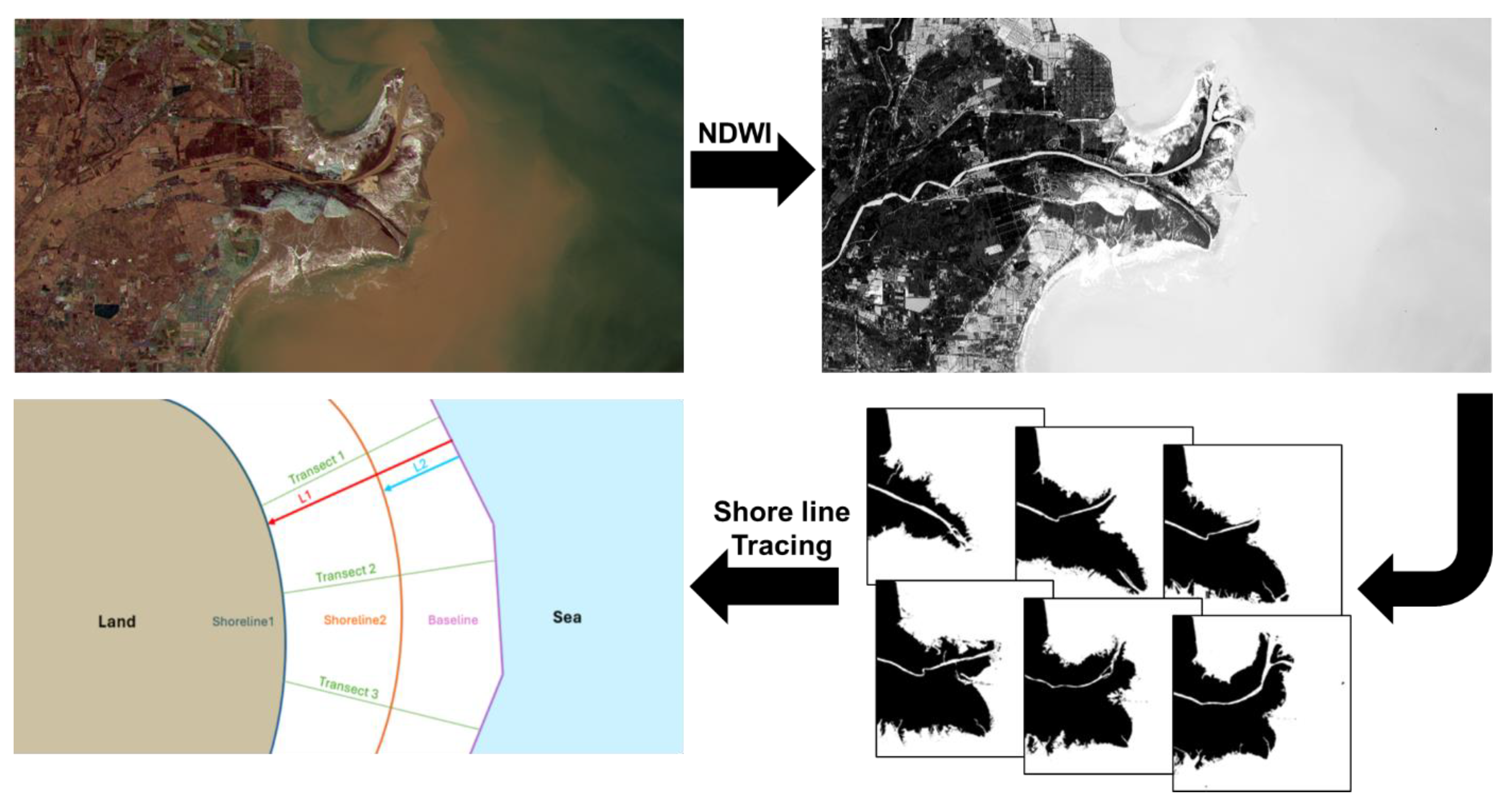

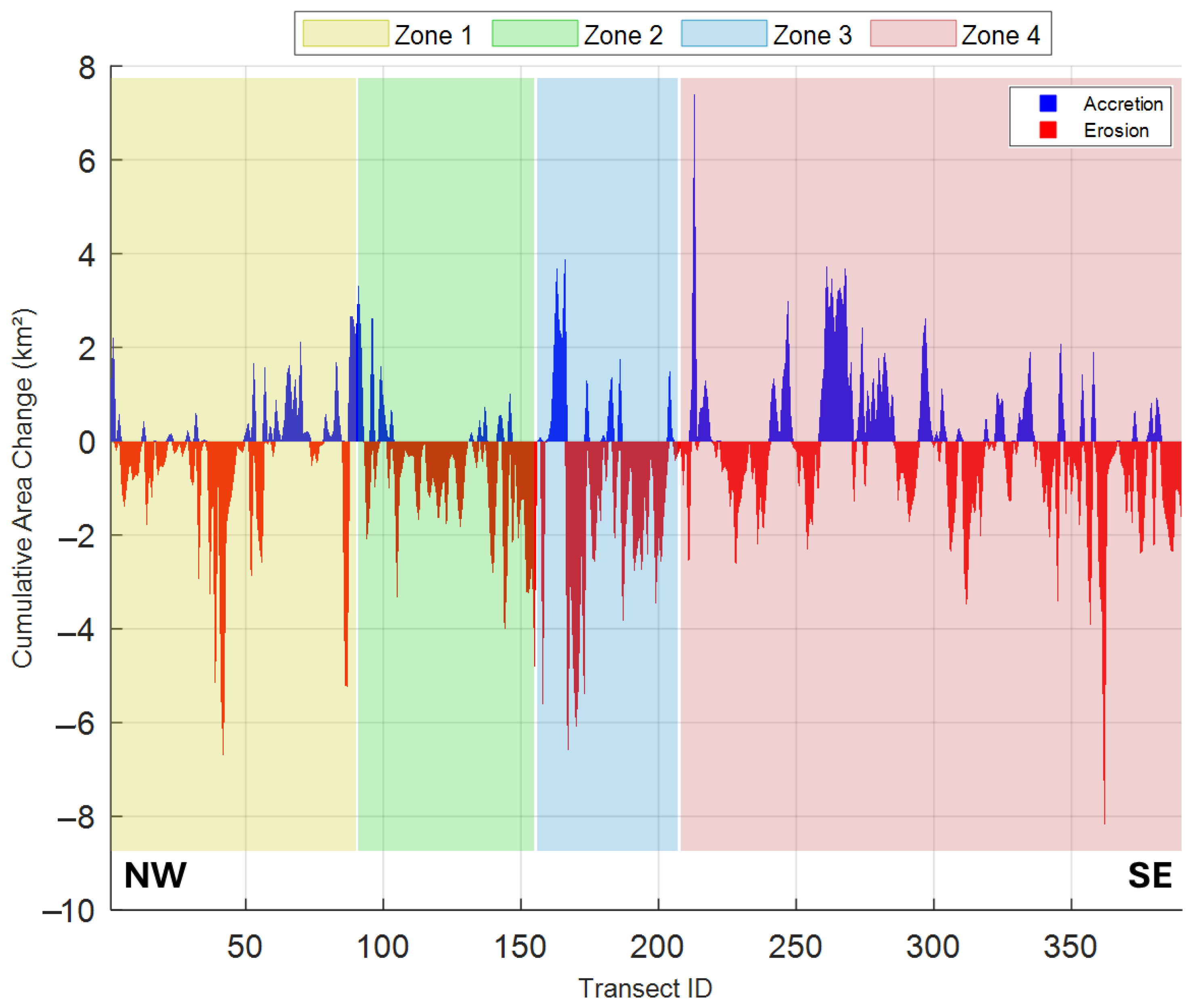
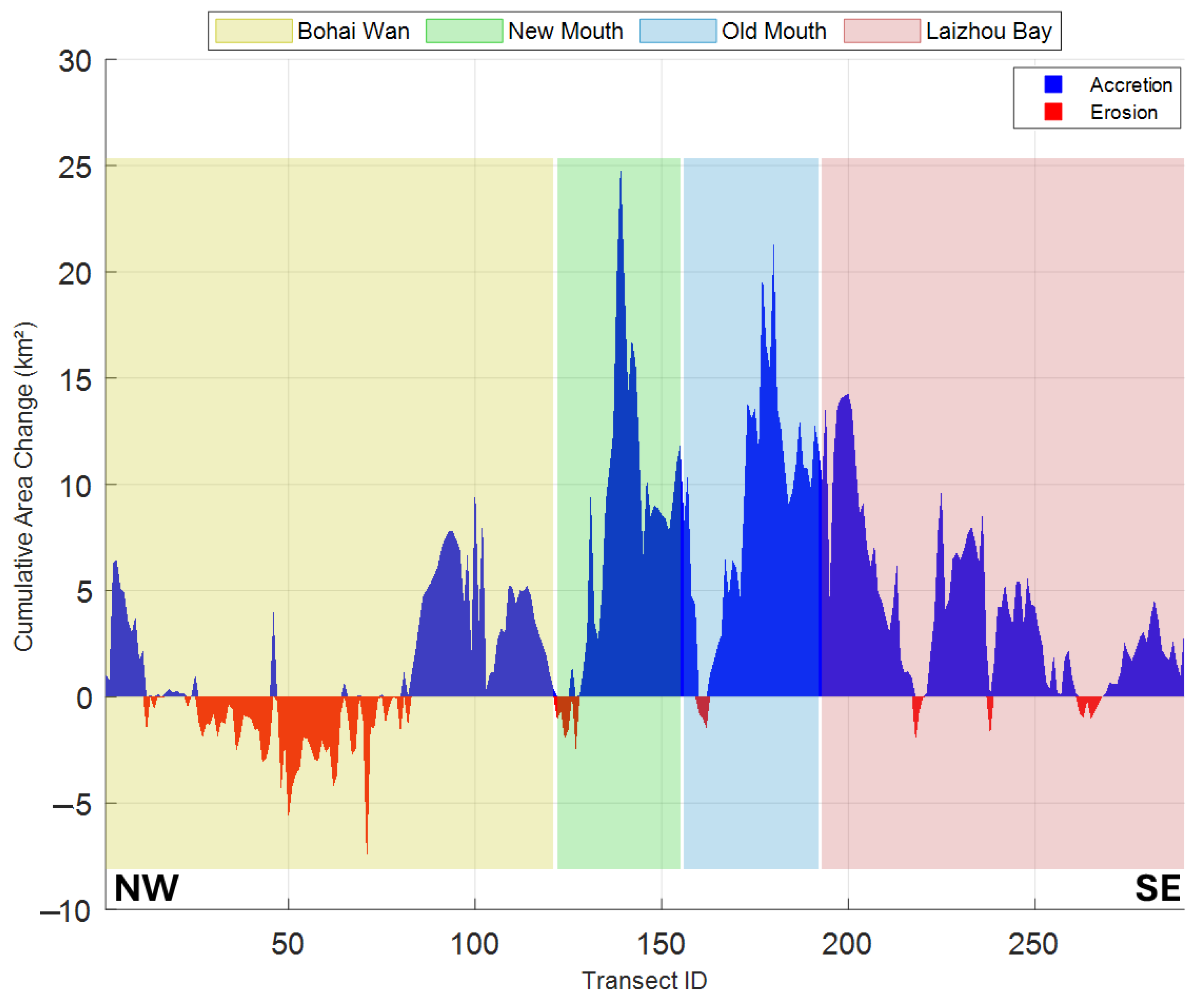

| Segment | Total Area Change (km2) | EPR Trend (m/year) | Dominated Process |
|---|---|---|---|
| East Alexandria | −0.24 | −1.17 | Erosion |
| Rosetta | −24.26 | +6.37 | Erosion |
| Burullus Lake | −9.83 | +0.37 | Erosion |
| West Damietta | −3.24 | +0.70 | Erosion |
| Damietta | +10.60 | +0.12 | Accretion |
| West Port Said | −0.33 | −0.16 | Erosion |
| Segment | Total Area Change (km2) | EPR Trend (m/year) | Dominated Process |
|---|---|---|---|
| Zone 1 | −38.79 | −4.38 | Erosion |
| Zone 2 | −53.71 | −3.00 | Erosion |
| Zone 3 | −64.68 | −6.01 | Erosion |
| Zone 4 | −45.16 | −4.58 | Erosion |
| Segment | Total Area Change (km2) | EPR Trend (m/year) | Dominated Process |
|---|---|---|---|
| Bohai Wan | +111.03 | −10.34 | Accretion |
| New Mouth | +274.97 | −40.09 | Accretion |
| Old Mouth | +331.05 | −129.49 | Accretion |
| Laizhou Bay | +392.49 | −34.56 | Accretion |
Disclaimer/Publisher’s Note: The statements, opinions and data contained in all publications are solely those of the individual author(s) and contributor(s) and not of MDPI and/or the editor(s). MDPI and/or the editor(s) disclaim responsibility for any injury to people or property resulting from any ideas, methods, instructions or products referred to in the content. |
© 2025 by the authors. Licensee MDPI, Basel, Switzerland. This article is an open access article distributed under the terms and conditions of the Creative Commons Attribution (CC BY) license (https://creativecommons.org/licenses/by/4.0/).
Share and Cite
Risha, M.; Liu, P. Event-Driven Shoreline Dynamics of the Nile, Indus, and Yellow River Deltas: A 50-Year Analysis of Trends and Responses. Earth 2025, 6, 120. https://doi.org/10.3390/earth6040120
Risha M, Liu P. Event-Driven Shoreline Dynamics of the Nile, Indus, and Yellow River Deltas: A 50-Year Analysis of Trends and Responses. Earth. 2025; 6(4):120. https://doi.org/10.3390/earth6040120
Chicago/Turabian StyleRisha, Muhammad, and Paul Liu. 2025. "Event-Driven Shoreline Dynamics of the Nile, Indus, and Yellow River Deltas: A 50-Year Analysis of Trends and Responses" Earth 6, no. 4: 120. https://doi.org/10.3390/earth6040120
APA StyleRisha, M., & Liu, P. (2025). Event-Driven Shoreline Dynamics of the Nile, Indus, and Yellow River Deltas: A 50-Year Analysis of Trends and Responses. Earth, 6(4), 120. https://doi.org/10.3390/earth6040120







